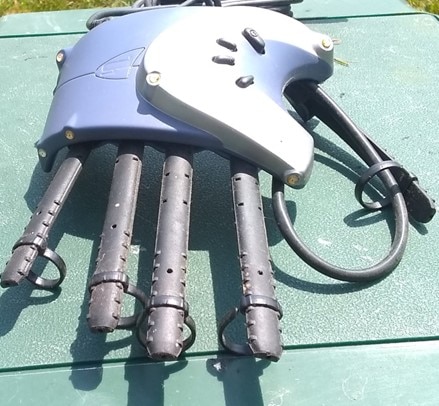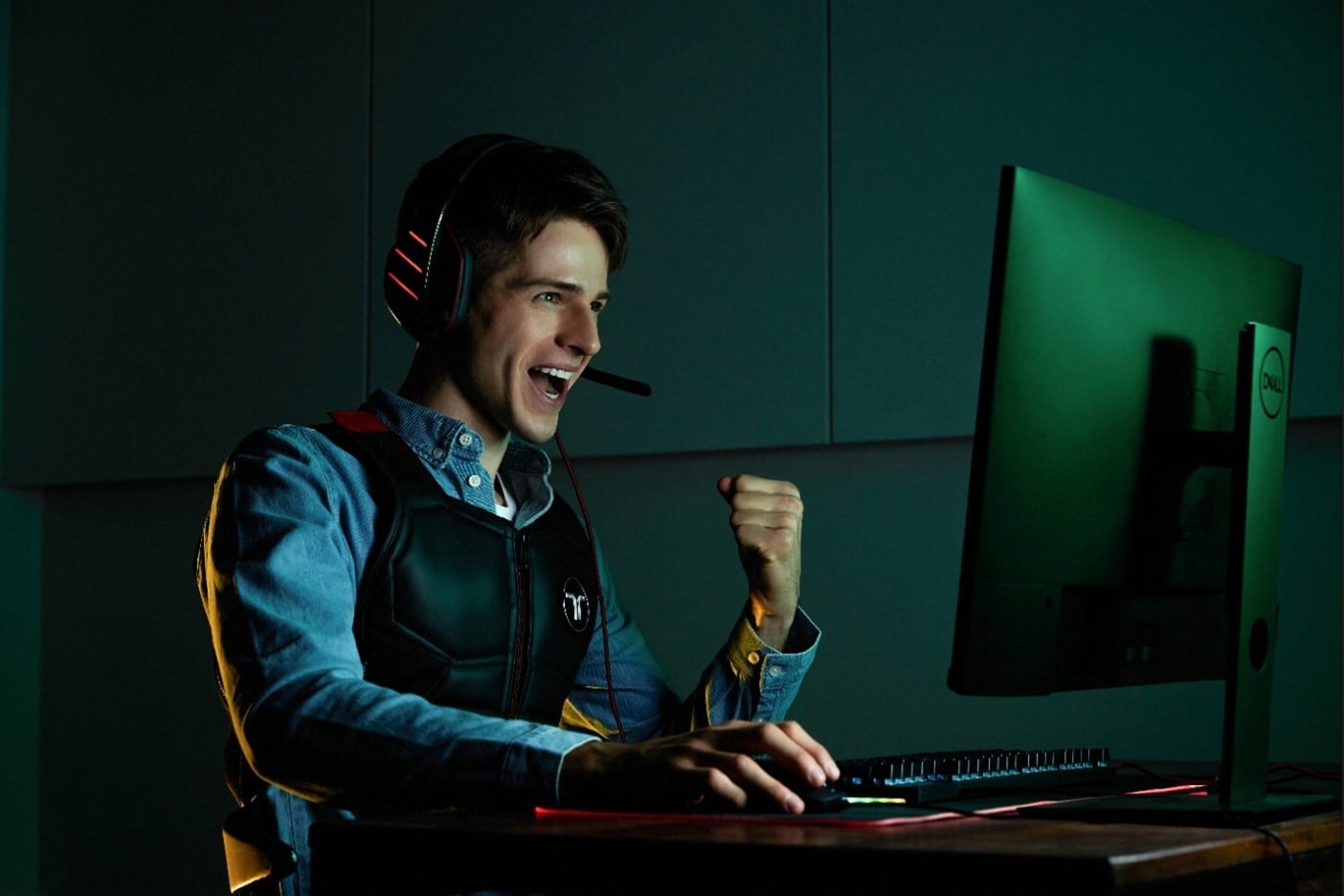The Future of Haptic Integration
Beyond the Visual in VR and AR

Image Source: VectorCookies/Stock.adobe.com; generated with AI)
By Jon Gabay for Mouser Electronics
Published October 20, 2023
Advanced virtual reality (VR) tricks our senses with its sophisticated graphics and audio, making us react instinctively to virtual cues. While its notable footprint is in gaming, VR, as well as augmented reality (AR), are now pivotal in professional realms, especially when combined with haptics. This combination of technologies lets us not only touch an object virtually but also discern its texture, temperature, and resistive force. Such tactile feedback becomes critical in specialized applications: For example, surgeons need to gauge resistance during remote procedures, technicians require a tangible grip assurance during satellite repairs, and automation engineers seek tactile confirmation when using virtual consoles. In essence, as VR and AR mature, the nuanced physical feedback they offer becomes paramount in precision tasks. The horizon promises an era where the tactile nuances of our digital interactions become indistinguishable from reality.
Haptic Gloves, Suits, and Chairs
Among the first widely adopted haptic technologies was the force feedback haptic glove. Dozens of manufacturers offer haptic gloves that provide programmed resistance to finger and hand movements, letting the user feel a virtual object's size, density, and weight. The gloves use magnetic friction brakes to accomplish resistance and the feel of the object. Some gloves can provide up to 20N of force, simulating the weight of a 2kg brick on each finger. Some gloves even have temperature control, allowing the user to feel the temperature of a remote object.
Haptic gloves must respond quickly, with minimal latency. This is especially important when a user is using immersive technology to train for a dangerous job, as it allows them to experience high-risk scenarios without the high risk. This low latency means that the user senses resistive force or another sensation as a gesture is performed in real time.
While VR and AR headsets use accelerometers to track head movement, gloves can use accelerometers, reflectometers, or video. Reflectometers can sense position by triangulating two (or more) IR sensors with one or more IR emitters, which can be in a headset, gaming console, or gloves (Figure 1).

Figure 1: The author created a motion-sensing glove that uses IR emitters at strategic locations to transmit to sensors elsewhere. Other motion-sensing gloves can embed sensors on the glove and triangulate from two or more emitters placed somewhere else. (Source: Author)
Sensing motion, gestures, and touches is only half the equation; the other half creates the wearer's physical sensations. Several exciting technologies have been developed for this purpose, including magnetic force (like a speaker cone movement), vibrational actuators, piezo arrays, and microfluidics. Some systems even use sonically produced force fields.
Similarly, body suits and vests filled with actuators let the wearer feel tactile stimulation across the body. Many companies make haptic vests primarily targeting the gaming market. One such device is the bHaptics TactSuit X40 (Figure 2); as the name suggests, the suit incorporates 40 vibration motors to provide immersive sense stimulation.

Figure 2: The bHaptics TactSuit X40 haptic vest contains 40 vibrational motor sense stimulators and offers wired or wireless connectivity. (Source: bHaptics)
Haptic chairs also offer a tactile experience. Primarily used in applications such as gaming and flight training, these chairs simulate G-forces, accelerations, and turbulence.
May the Force Be on You
Sensory illusions have advanced significantly, enabling users to feel like they're truly touching objects in a dynamic digital environment. Notably, using ultrasonic emitters, sonic force fields create wavefronts that converge on a target, allowing users to feel tactile sensations.
For example, the Ultraleap Leap Motion Controller 2 exemplifies this by using video-based hand tracking for 3D interactions. Its advanced video imaging detects hand motions and orientations. The controller can be paired with an ultrasonic transducer array, which directs air pressure to specific locations, enabling users to feel tactile sensations, from a button click to holding a ball.
What's Next?
All of these current technologies hint at a future where our digital experiences span across all the senses, melding the physical and digital worlds. Here are some potential ways in which haptic technology, combined with other sensory feedback systems, could shape our near future:
Healthcare Rehabilitation & Training
Haptics could transform physical rehabilitation practices. Devices equipped with tactile feedback can guide patients through precise movement patterns. For instance, for patients relearning arm movement, haptic devices can provide resistance or vibrational cues when patients deviate from the correct posture, enabling therapists to digitally "feel" and adjust patients' movements even from miles away.
Real Estate and Architecture
Haptics can change property tours and architectural showcases beyond 3D models and virtual walkthroughs. Simulating the sensation of various materials, such as the grain of a wooden floor or the plushness of a carpet, haptics can provide a tactile layer to digital tours, helping clients connect with a space or design without physically being there.
Art and Digital Creation
Artistry in the digital realm is set to gain a tangible dimension. With haptic tools, artists can experience the sensation of the materials they're working on within a virtual space, be it the malleability of clay or the hardness of stone. This tactile interface can enrich the creation process, making digital artistry feel as natural as traditional methods.
Education
Haptic technology promises hands-on learning, even in a digital classroom. Students will be able to feel virtual objects of study—from the surfaces of historical artifacts to the intricate structure of a molecule. This additional tactile layer to education could foster better understanding and engagement.
Gaming and Entertainment
The gaming world will become indistinguishably immersive—even more than it currently is. Gamers equipped with haptic suits or controllers will not just see or hear their virtual surroundings but will feel them. Whether it's an alien planet's texture or arrows' impact in a medieval warfare game, haptics will make the gaming world come alive.
Personal Relationships
Distance might become less daunting in relationships with haptic interfaces. Wearable devices could simulate real-time physical sensations, turning a simple video call into a virtual hand-holding session. Through haptic feedback, a gentle squeeze on one end could be felt as a reassuring touch on the other, narrowing the emotional gap across miles.
In all these fields, haptics acts as a bridge between the digital and tangible, strengthening the realism of virtual interactions. As we progress, the intricate blend of touch with visual and auditory feedback will redefine our experiences, weaving a richer tapestry of reality and virtuality.
Conclusion
Haptics can play a key role in advancing human capabilities, protecting workers from hazardous environments, providing remote control of systems, enabling medical procedures from afar, and more. The delicate sensation of touch is crucial for knowing when someone is using enough force or too much. That's where good quality and calibrated haptics come into play.
Expect to see haptics develop and be used in military, medical, industrial, agricultural, aerospace, and factory settings, as well as gaming and other professions. We are at the beginning stages of a new technology revolution.